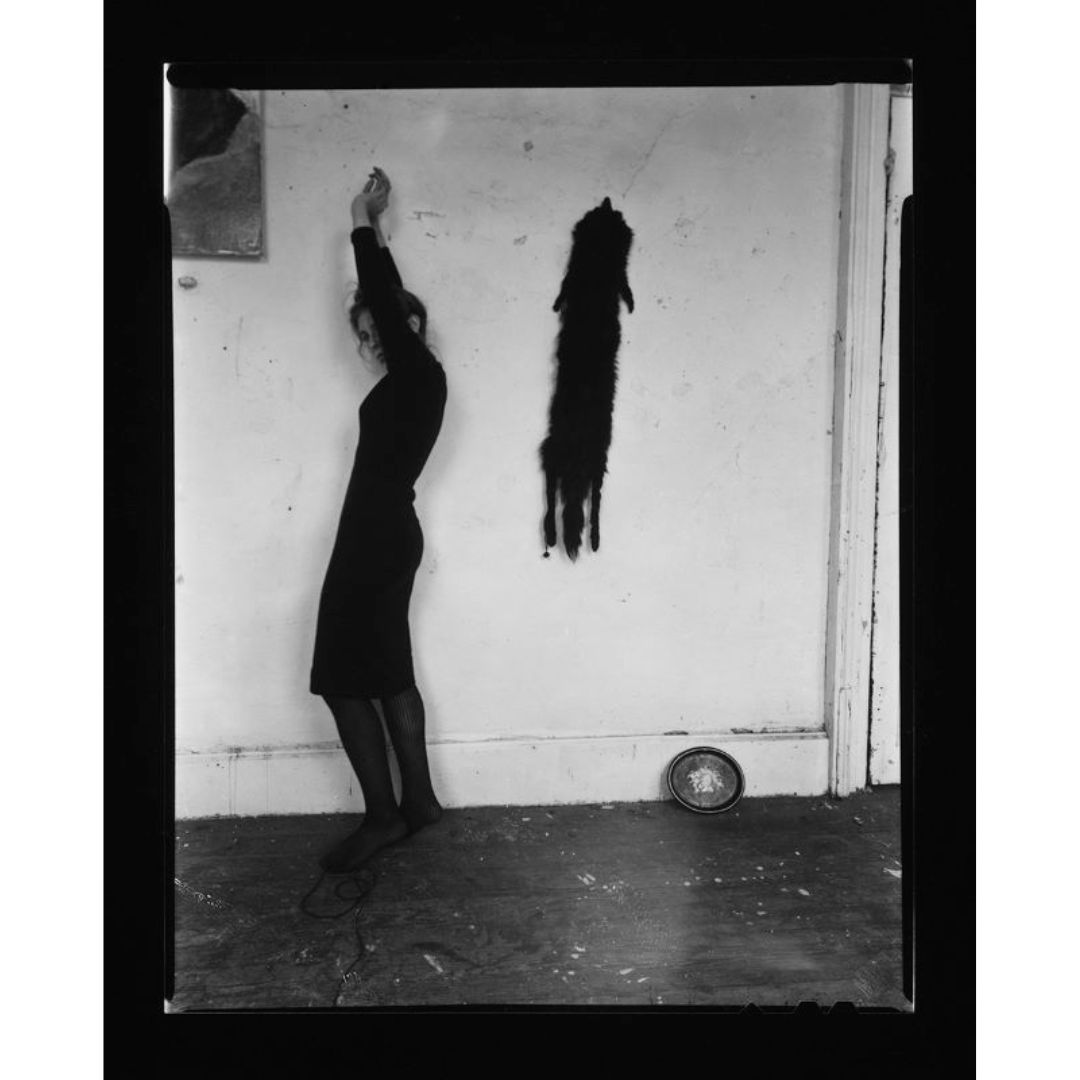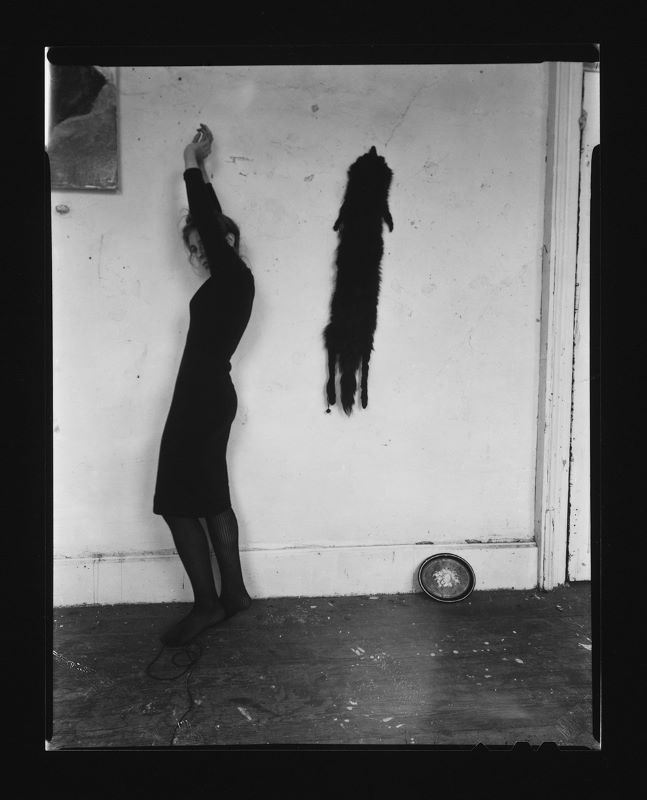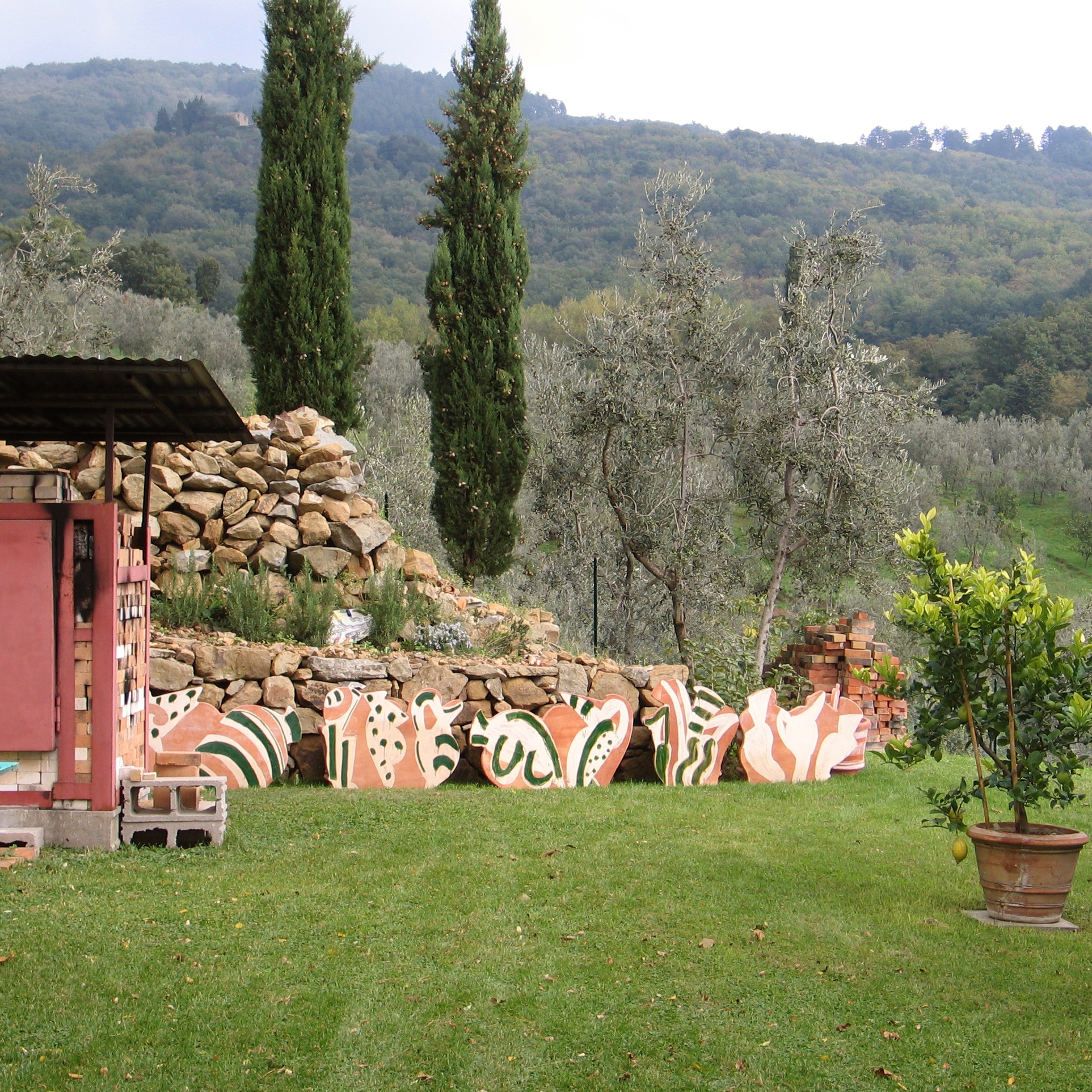L to R: “Three Views of Eleonora,” 2011. 18 x 24 in / “A Geometric Investigation II,” 2009. 24 x 20 in / “Variation on Vermeer,” 2010. 24 x 20 in / “Vermeer and Sleeping Eleonora,” 2010. 59 x 41 1/2 in / George Woodman with Eleonora Picheca, 2011. Courtesy Eleonora Picheca. All gelatin silver prints. All works by George Woodman © Woodman Family Foundation / Artists Rights Society (ARS), New York
George Woodman. “Three Views of Eleonora,” 2011. 18 x 24 in. Gelatin silver print © Woodman Family Foundation / Artists Rights Society (ARS), New York
George Woodman's photographs of model Eleonora Picheca, 2008-2012
Thanks to Eleonora for sharing a photo of her and George laughing together (last slide). It reminded us of some of the beautiful photographs George took of her over the years when she sat for him in Italy (2008-2012).
L to R: Charles Woodman, Venice, Italy, 1966 / Charles Woodman and Francesca Woodman, Venice, Italy, 1966 / Betty Woodman and Charles Woodman, Venice, Italy, 1966. Woodman Family Foundation Archives.
Charles Woodman, Venice, Italy, 1966. Woodman Family Foundation Archives.
The Woodmans in Venice, Italy, 1966
As this year’s Venice Biennale, “The Milk of Dreams,” nears its end, we’re reminded that over many decades Betty and George Woodman traveled to Venice to take in the Biennale. Their trip in 1966—pictured here—when the family spent the year in Italy, was likely Charlie and Francesca’s first of many visits there, to explore both the exhibition and this captivating city.
L to R: “Untitled,” c. 1979-80. 5 x 3 15/16 in. | Francesca Woodman's vintage fox fur from WFF Archives | “Untitled,” c. 1979-80. 7 1/2 x 4 3/4 in | “Untitled,” 1979, 5 13/16 x 5 13/16 in | “Untitled,” 1978, 34 1/2 x 40 1/2 in | “Untitled,” 1976. 5 3/4 x 5 3/4 in | “Untitled,” 5 7/8 x 5 7/8 in. All gelatin silver prints. All works by Francesca Woodman © Woodman Family Foundation / Artists Rights Society (ARS), New York
Francesca Woodman. “Untitled,” c. 1979-80. 5 x 3 15/16 in. Gelatin silver print © Woodman Family Foundation / Artists Rights Society (ARS), New York
Vintage fox fur from Francesca Woodman's archives used in her work, 1976-80
The Foundation’s archives include many of the dresses, shoes, scarves, gloves and other clothing that Francesca Woodman used in her photographs and in her daily life. This fox fur, probably picked up at a vintage shop or flea market like much that she wore, makes an appearance in many of her photographs.
L to R: Betty Woodman, Italy, c. 1965-66 / Betty Woodman, Charles Woodman, and Francesca Woodman, Italy, c. 1960s / Charles Woodman and friend, Italy, c. 1966 / Betty Woodman and friends, Italy, c. 1966 / Betty Woodman, Francesca Woodman, and friend, Antella, Italy, c. 1968 / Betty Woodman and friends, Antella, Italy, c. 1980 / Betty Woodman, Antella, Italy, c. 1995 / George Woodman, Antella, Italy, c. 1995 / Betty Woodman, George Woodman, and friends, Antella, Italy, c. 1995. Woodman Family Foundation Archives.
Betty Woodman, Italy, c. 1965-66. Woodman Family Foundation Archives.
Dining al fresco with the Woodman family, c. 1960s-1995
The Woodman family spent many summer days and evenings dining al fresco in Italy with family and friends throughout the years. Most of these snapshots were taken by George, who often had his camera in hand and documented their family life.
George Woodman, c. 1960s-1990s. Woodman Family Foundation Archives.
George Woodman, c. 1960s. Woodman Family Foundation Archives.
George Woodman's summer travels, c. 1960s-1990s
Here are a series of portraits of George Woodman, an avid world traveler. George soaked up endless inspiration for art making and life on the family's summer travels throughout the years.
L to R: 1 & 3: Installation view, MacDowell Colony, Peterborough, New Hampshire, 1980 | "Study for Tree Piece,” c. 1980. 14 1/2 x 15 1/4 in. Diazotype / 4-5: “Untitled,” 1980. 2 13/16 x 9 15/16 in. Gelatin silver print. Letter on reverse of print | “Untitled,” 1980. 11 x 14 in. Gelatin silver print. All works by Francesca Woodman © Woodman Family Foundation / Artists Rights Society (ARS), New York
Francesca Woodman. Installation view, MacDowell Colony, Peterborough, New Hampshire, 1980. Woodman Family Foundation Archives.
Francesca Woodman, MacDowell Colony, Peterborough, New Hampshire, 1980
Francesca Woodman spent three weeks in July of 1980 on a fellowship at the MacDowell Colony, surrounded by other artists, as well as musicians, poets, novelists and the forests of rural New Hampshire. She arrived there from New York, already thinking about trees.
The Woodman family and friends throughout the years in Antella, Italy, c. 1960s-2010s. Woodman Family Foundation Archives.
The Woodman family and friends, Antella, Italy, c. 1960s. Woodman Family Foundation Archives.
The breakfast nook, Antella, Italy, c. 1960s-2010s
For over fifty years, the Woodman family has enjoyed many meals and conversations in the breakfast nook at their farmhouse in Antella, Italy. Built in a circular space that had originally housed a brick oven, the nook overlooks the hills of Tuscany and spectacular sunsets.
L to R: Installation views: "Pitti rivisatto,” Palazzo Pitti, Florence, Italy, 1997. Woodman Family Foundation Archives | 2: “Pitti, Medea, Roses,” c. 1988. 41 1/4 x 72 in / 4: “Untitled,” 1990. 41 1/4 x 78 in. | 6: “Untitled,” c. 1990s. 24 x 20 in. | 9: “Lovers within Venus,” 1990. 41 1/4 x 59 in. All gelatin silver prints. All works by George Woodman © Woodman Family Foundation / SIAE, Rome
Installation view, "Pitti rivisatto,” Palazzo Pitti, Florence, Italy, 1997. Woodman Family Foundation Archives.
George Woodman, “Pitti rivisatto," Palazzo Pitti, Florence, Italy, 1997
Twenty-five years ago this month, George Woodman’s solo exhibition, "Pitti rivisatto," opened at the Palazzo Pitti in Florence, and remained on view all summer long. His layered black and white photographs take this Renaissance palace as their subject, but also as an opportunity to reflect on time and the experiences carried within each viewer.
L to R: 1-2: "Segno: Notiziario di arte contemporanea," Issue 9, Summer 1978. Woodman Family Foundation Archives | Francesca Woodman. "From Space²” or "Space²", 1976, from the "Space²" series, 5 1/4 x 5 1/4 in. Gelatin silver print © Woodman Family Foundation / Artists Rights Society (ARS), New York
"Segno: Notiziario di arte contemporanea," Issue 9, summer 1978. Woodman Family Foundation Archives.
Francesca Woodman, Segno Magazine, 1978
In the summer of 1978, Francesca Woodman’s photograph "From Space²" or "Space²" was featured in the Italian contemporary art magazine “Segno.” In the accompanying text, she explained that her original idea for the image came from her desire to illustrate literary metaphors but evolved over a group of photographs into a kind of story following a figure who explores these metaphors.
L to R: 1-6: Betty Woodman. “Impruneta Flower Pots,” c. 1998-2004. Variable dimensions. Terracotta. Views in Antella, Italy | Betty Woodman with Tullio Orlandi, Italy, c. 1998-2004. Woodman Family Foundation Archives.
Betty Woodman. “Impruneta Flower Pots,” c. 1998-2004. Variable dimensions. Terracotta. Views in Antella, Italy. Woodman Family Foundation Archives.
Betty Woodman, "Impruneta Flowers Pots," c. 1998-2004, Antella, Italy
Over summers spent in Antella, Italy, Betty Woodman often developed projects which could only be realized there. From 1998-2004, she collaborated with a pottery in Impruneta—a nearby town renowned for its terra cotta clay—enlivening their standard-issue garden planters with her vase-shaped façades and signature brushstrokes.
L to R: "War Sadness Escape," 1999. 42 x 39 in. | 2 & 4: Installation views, “Contrapposto & Other Stories,” Jeff Bailey Gallery, New York, 2014 | "Boboli: Fountain of Neptune,” 1997. 71 3/4 x and 41 1/4 in. All gelatin silver prints. All works by George Woodman © Woodman Family Foundation / Artists Rights Society (ARS), New York
George Woodman. “War Sadness Escape,” 1999. 42 x 39 in. Gelatin silver print © Woodman Family Foundation / Artists Rights Society (ARS), New York
George Woodman's camera obscura photographs in "Contrapposto & Other Stories," Jeff Bailey Gallery, New York, 2014
Summertime is here again, and each year it has brought with it a fresh crop of summer group shows around New York City. Here’s one from 2014: George Woodman’s camera obscura photographs were included in “Contrapposto & Other Stories,” curated by Katia Rosenthal at Jeff Bailey Gallery in Chelsea.
L to R: 1-2: Installation views of Betty Woodman's “Horizontal Garden” (2005), The Great Hall, The Metropolitan Museum of Art, 2006. 29 x 32 x 18 in. Glazed earthenware | Installation view of “The Art of Betty Woodman,” The Metropolitan Museum of Art, New York, NY, April 25—July 30, 2006. Photo: Eli Ping
Installation view of Betty Woodman's “Horizontal Garden” (2005), The Great Hall, The Metropolitan Museum of Art, 2006. 29 x 32 x 18 in. Glazed earthenware. Photo: Eli Ping.
Betty Woodman, Met Vases, 2006
Spring flowers always remind us of Betty Woodman, and particularly her vases in the Great Hall of the Metropolitan Museum of Art, which greeted visitors to the museum with their bold colors, overlapping patterns and allusions to vases and gardens, holding an ever-changing display of seasonal blooms. They were installed on the occasion of her 2006 retrospective there—the first time the museum dedicated such an exhibition to a living woman artist.
























